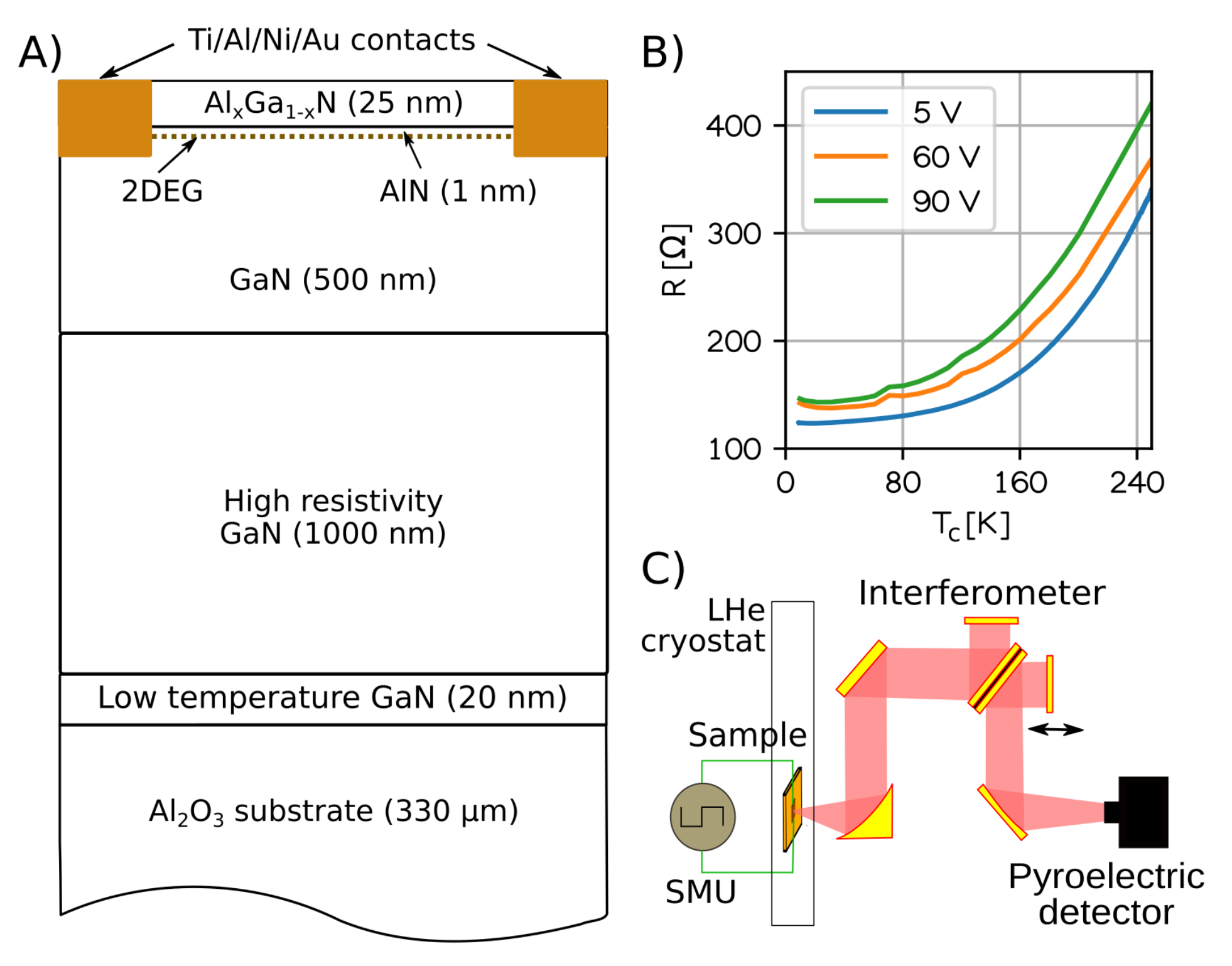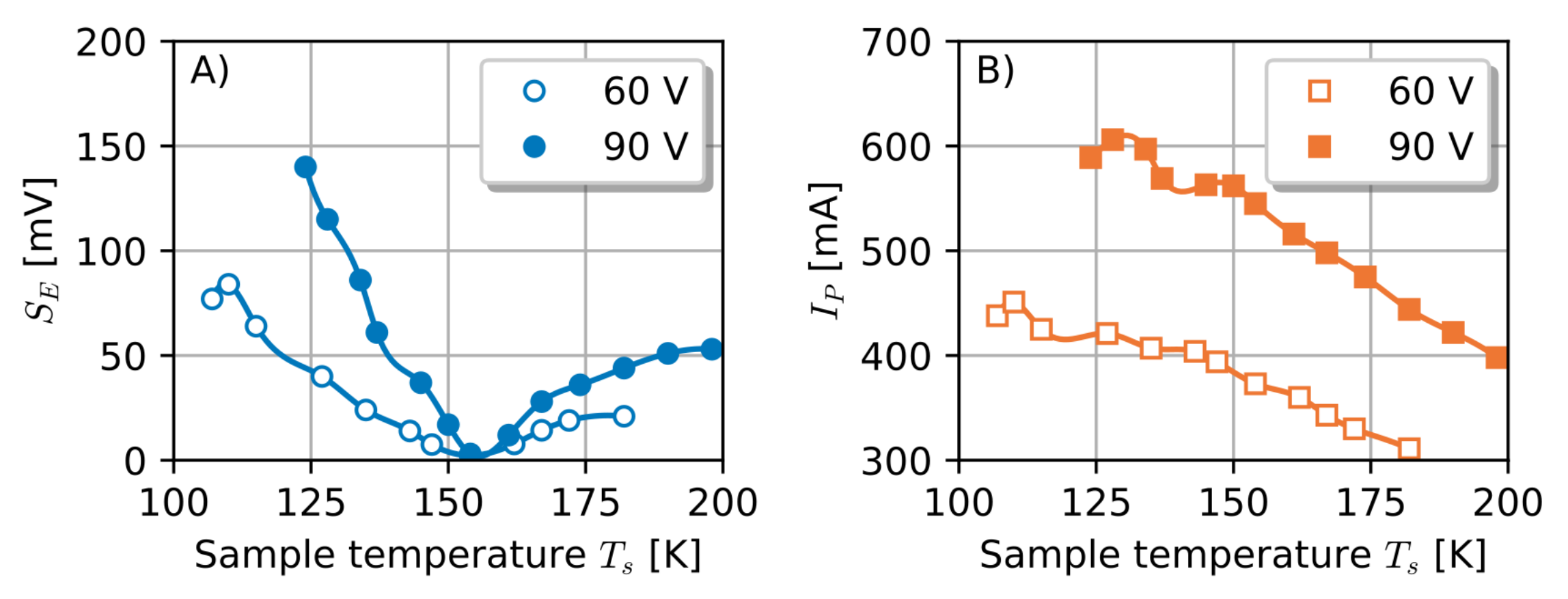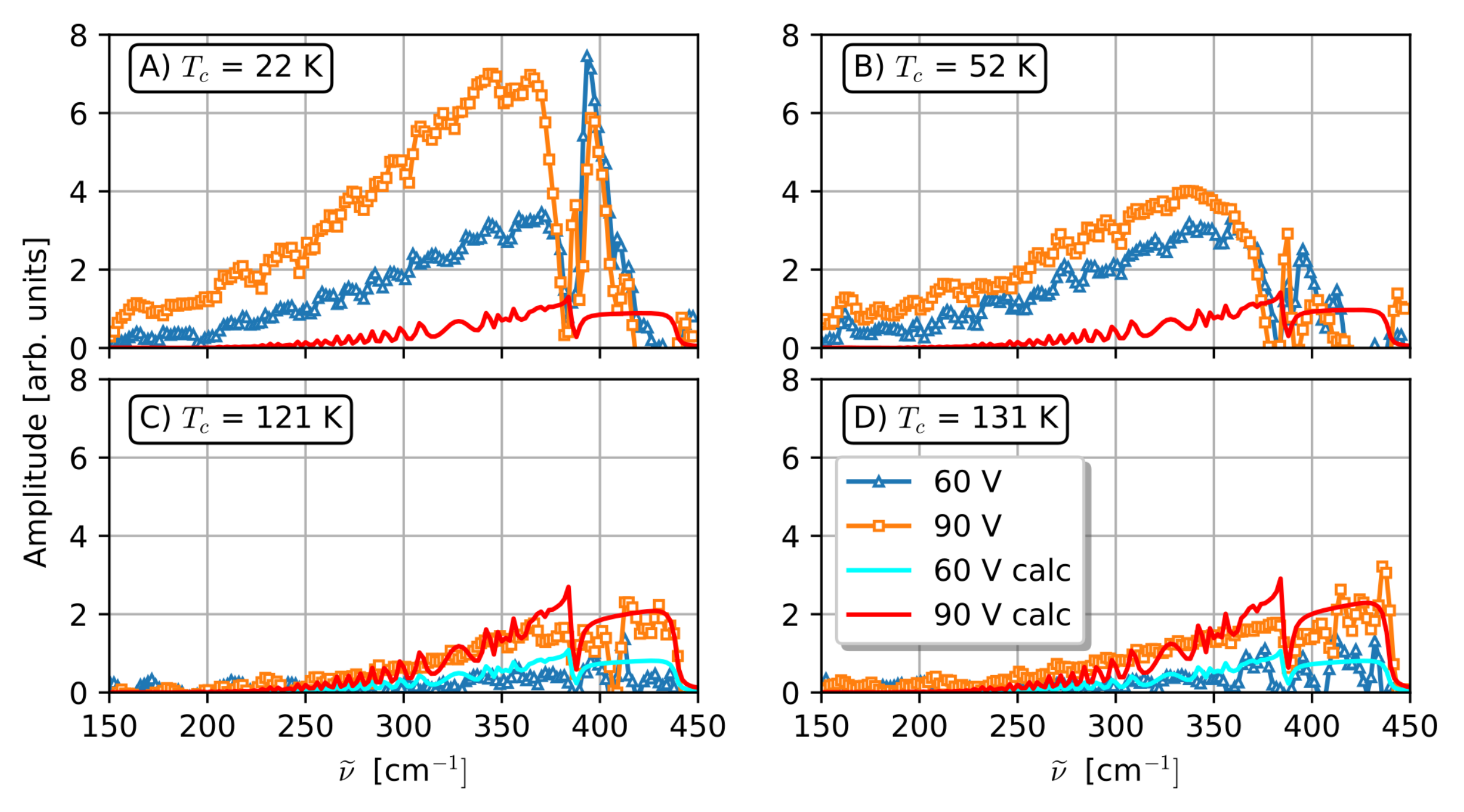Terahertz Spectroscopy of Thermal Radiation from AlGaN/GaN Heterostructure on Sapphire at Low Temperatures
Abstract
1. Introduction
2. Materials and Methods
3. Results
4. Discussion
5. Conclusions
Author Contributions
Funding
Acknowledgments
Conflicts of Interest
Abbreviations
| THz | terahertz |
| FET | field-effect transistor |
| HEMT | high-electron mobility transistor |
| 2DEG | two-dimensional electron gas |
| RCWA | rigorous coupled wave analysis |
References
- Dhillon, S.; Vitiello, M.; Linfield, E.; Davies, A.; Hoffmann, M.C.; Booske, J.; Paoloni, C.; Gensch, M.; Weightman, P.; Williams, G.; et al. The 2017 terahertz science and technology roadmap. J. Phys. Appl. Phys. 2017, 50, 043001. [Google Scholar] [CrossRef]
- Łusakowski, J.; Teppe, F.; Dyakonova, N.; Meziani, Y.M.; Knap, W.; Parenty, T.; Bollaert, S.; Cappy, A.; Popov, V.; Shur, M.S. Terahertz generation by plasma waves in nanometer gate high electron mobility transistors. Phys. Status Solid. 2005, 202, 656. [Google Scholar] [CrossRef]
- Ikamas, K.; Nevinskas, I.; Krotkus, A.; Lisauskas, A. Silicon Field Effect Transistor as the Nonlinear Detector for Terahertz Autocorellators. Sensors 2018, 18, 3735. [Google Scholar] [CrossRef] [PubMed]
- Zagrajek, P.; Danilov, S.N.; Marczewski, J.; Zaborowski, M.; Kolacinski, C.; Obrebski, D.; Kopyt, P.; Salski, B.; But, D.; Knap, W.; Ganichev, S.D. Time Resolution and Dynamic Range of Field-Effect Transistor–Based Terahertz Detectors. J. Infrared Millim. Terahertz Waves 2019. [Google Scholar] [CrossRef]
- Otsuji, T.; Watanabe, T.; Moutaouakil, A.; Karasawa, H.; Komori, T.; Satou, A.; Suemitsu, T.; Suemitsu, M.; Sano, E.; Knap, W. Emission of terahertz radiation from two-dimensional electron systems in semiconductor nano-and hetero-structures. J. Infrared Millim. Terahertz Waves 2010, 32, 629. [Google Scholar] [CrossRef]
- El Fatimy, A.; Dyakonova, N.; Meziani, Y.; Otsuji, T.; Knap, W.; Vandenbrouk, S.; Madjour, K.; Théron, D.; Gaquiere, C.M.P. Nanofabrication Techniques and Their Applications to Terahertz Science and Technology. J. Appl. Phys. 2010, 107, 024504. [Google Scholar] [CrossRef]
- Lisauskas, A.; Rämer, A.; Burakevič, M.; Chevtchenko, S.; Krozer, V.; Heinrich, W.; Roskos, H.G. Terahertz emission from biased AlGaN/GaN high-electron-mobility transistors. J. Appl. Phys. 2019, 125, 151614. [Google Scholar] [CrossRef]
- Shalygin, V.A.; Moldavskaya, M.D.; Vinnichenko, M.Y.; Maremyanin, K.V.; Artemyev, A.A.; Panevin, V.Y.; Vorobjev, L.E.; Firsov, D.A.; Korotyeyev, V.V.; Sakharov, A.V.; et al. Selective terahertz emission due to electrically excited 2D plasmons in AlGaN/GaN heterostructure. J. Appl. Phys. 2019, 126, 183104. [Google Scholar] [CrossRef]
- Jakštas, V.; Grigelionis, I.; Janonis, V.; Valušis, G.; Kašalynas, I.; Seniutinas, G.; Juodkazis, S.; Prystawko, P.; Leszczyński, M. Electrically driven terahertz radiation of 2DEG plasmons in AlGaN/GaN structures at 110 K temperature. Appl. Phys. Lett. 2017, 110, 202101. [Google Scholar] [CrossRef]
- Grigelionis, I.; Jorudas, J.; Jakštas, V.; Janonis, V.; Kašalynas, I.; Prystawko, P.; Kruszewski, P.; Leszczyński, M. Terahertz electroluminescence of shallow impurities in AlGaN/GaN heterostructures at 20 K and 110 K temperature. Mater. Sci. Semicond. Process. 2019, 93, 280–283. [Google Scholar] [CrossRef]
- Jakštas, V.; Kašalynas, I.; Šimkienė, I.; Strazdienė, V.; Prystawko, P.; Leszczyński, M. Schottky diodes and high electron mobility transistors of 2DEG AlGaN/GaN structures on sapphire substrate. Lith. J. Phys. 2015, 54, 4. [Google Scholar] [CrossRef]
- Sai, P.; Jorudas, J.; Dub, M.; Sakowicz, M.; Jakštas, V.; But, D.B.; Prystawko, P.; Cywinski, G.; Kašalynas, I.; Knap, W.; Rumyantsev, S. Low frequency noise and trap density in GaN/AlGaN field effect transistors. Appl. Phys. Lett. 2019, 115, 183501. [Google Scholar] [CrossRef]
- Schubert, M.; Tiwald, T.E.; Herzinger, C.M. Infrared dielectric anisotropy and phonon modes of sapphire. Phys. Rev. B 2000, 61, 8187–8201. [Google Scholar] [CrossRef]
- Buckeridge, J.; Catlow, C.R.A.; Scanlon, D.O.; Keal, T.W.; Sherwood, P.; Miskufova, M.; Walsh, A.; Woodley, S.M.; Sokol, A.A. Determination of the Nitrogen Vacancy as a Shallow Compensating Center in GaN Doped with Divalent Metals. Phys. Rev. Lett. 2015, 114, 016405. [Google Scholar] [CrossRef] [PubMed]
- The RCWA MATLAB Code Was Developed for Free Release and Distribution in Professor Zhuomin Zhang’s Group at Georgia Institute of Technology. Available online: http://zhang-nano.gatech.edu/Rad_Pro.htm (accessed on 18 June 2018).
- Gervais, F.; Piriou, B. Anharmonicity in several-polar-mode crystals: adjusting phonon self-energy of LO and TO modes in Al2O3 and TiO2 to fit infrared reflectivity. J. Phys. Solid State Phys. 1974, 7, 2374. [Google Scholar] [CrossRef]
- Link, A.; Bitzer, K.; Limmer, W.; Sauer, R.; Kirchner, C.; Schwegler, V.; Kamp, M.; Ebling, D.G.; Benz, K.W. Temperature dependence of the E2 and A1(LO) phonons in GaN and AlN. J. Appl. Phys. 1999, 86, 6256–6260. [Google Scholar] [CrossRef]
- Shalygin, V.A.; Vorobjev, L.E.; Firsov, D.A.; Sofronov, A.N.; Melentyev, G.A.; Lundin, W.V.; Nikolaev, A.E.; Sakharov, A.V.; Tsatsulnikov, A.F. Blackbody-like emission of terahertz radiation from AlGaN/GaN heterostructure under electron heating in lateral electric field. J. Appl. Phys. 2011, 109, 073108. [Google Scholar] [CrossRef]
- Grigelionis, I.; Prystawko, P.; Jorudas, J.; Kašalynas, I. Electrically-controlled THz emission from AlGaN/GaN/Al2O3 high electron mobility transistor structures at a temperature of 20 K. In Proceedings of the 2019 44th International Conference on Infrared, Millimeter, and Terahertz Waves (IRMMW-THz), Paris, France, 6 September 2019; pp. 1–2. [Google Scholar] [CrossRef]



© 2020 by the authors. Licensee MDPI, Basel, Switzerland. This article is an open access article distributed under the terms and conditions of the Creative Commons Attribution (CC BY) license (http://creativecommons.org/licenses/by/4.0/).
Share and Cite
Grigelionis, I.; Kašalynas, I. Terahertz Spectroscopy of Thermal Radiation from AlGaN/GaN Heterostructure on Sapphire at Low Temperatures. Appl. Sci. 2020, 10, 851. https://doi.org/10.3390/app10030851
Grigelionis I, Kašalynas I. Terahertz Spectroscopy of Thermal Radiation from AlGaN/GaN Heterostructure on Sapphire at Low Temperatures. Applied Sciences. 2020; 10(3):851. https://doi.org/10.3390/app10030851
Chicago/Turabian StyleGrigelionis, Ignas, and Irmantas Kašalynas. 2020. "Terahertz Spectroscopy of Thermal Radiation from AlGaN/GaN Heterostructure on Sapphire at Low Temperatures" Applied Sciences 10, no. 3: 851. https://doi.org/10.3390/app10030851
APA StyleGrigelionis, I., & Kašalynas, I. (2020). Terahertz Spectroscopy of Thermal Radiation from AlGaN/GaN Heterostructure on Sapphire at Low Temperatures. Applied Sciences, 10(3), 851. https://doi.org/10.3390/app10030851





